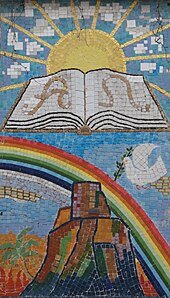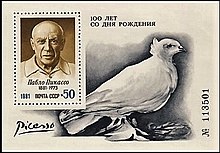Dove of peace

In addition to other peace symbols , the dove is seen as a symbol of peace . In this context she is called the dove of peace .
The symbol of the peace dove has no behavioral equivalent in the street pigeon , which is involved in an estimated 2,000 fights a year.
Pigeon as an attribute
In pre-biblical times the dove was a symbol of peace for the goddess Har and the Harines, the temple servants, a deep cultural foundation of Mediterranean interpretations of peace. The “exalted dove”, Yahu , was originally the sexual aspect of the Sumerian Inanna . The patriarchally oriented Semitic tribes adopted the symbol from her. For them the dove was an important sacrificial animal , but its sexual-energetic component of peace from harmony of dualities was suppressed. According to Wolfgang Dietrich's thesis, the dove as an energetic symbol of peace for female sexuality and the union of opposites became the moral-ascetic peace symbol of the Holy Spirit .
In profane iconography, the dove is a symbol of peace, as a pair of doves or as a single dove an attribute of the Roman goddess Venus and in modern emblematic an attribute of Luxuria .
Dove in the bible
The dove plays the role of the good ambassador in the biblical story of the Flood : A dove left out by Noah returns to the ark with a fresh olive branch in its beak ( Gen 8.11 EU ). The biblical tale of the Flood begins in Gen 6.5–7 EU with a kind of declaration of war by God on people and creation, because “the earth is full of violence” ( Gen 6.13 EU ). The return of the dove with the olive branch is therefore understood as a sign of peace. Both the dove and the olive branch become symbols of peace .
Peace Movement Symbol
For the World Peace Congress in Paris in 1949, Pablo Picasso designed and lithographed the silhouette of a dove . His daughter was born on the evening of the Congress, and he named her Paloma ( Spanish for pigeon). In 1955 he received the World Peace Prize for his lithograph . Since then, the dove of peace has been a worldwide symbol for peace and the peace movement . She inspired writers for children's songs as well as graphic designers and artists who used this symbol in their work. Picasso himself used this motif several times for some of his other works.
For the Capitol complex in Chandigarh (India), the Swiss-French architect Le Corbusier created the sculpture of the "open hand" in the 1950s, which can also be interpreted as a dove of peace.
The well-known peace logo, the white dove on a blue background as a symbol of the peace movement, was designed by the Finnish graphic artist Mika Launis (* 1949) based on a 1974 photo of a dove by the Finnish magician Pekka Kärkkäinen . The Financial Times Deutschland gave her the name Pulu ( Finnish for pigeon) in October 2006 . A distinctive feature of this logo is a gap in the tail of the pigeon that was caused by a collision with a headlight when the photo was taken.
Later, the dove of peace even appeared in symbols of parties and various organizations. Dove releases were and are staged at the beginning of peaceful, sporting events and also on the occasion of weddings.
Use in the GDR
The peace dove was also used in the GDR , for example on the highest value of the five-year plan stamp series and on the never issued 200-mark note with the watermark of a peace dove.
A dove of peace is shown in the city arms of Eisenhüttenstadt , as a mural on the north facade of the Magnet department store in the former Leninallee (today Lindenallee) in Eisenhüttenstadt (mosaic by Walter Womacka ), as a symbol of the International Peace Tour and in the logo of the Berlin Ensemble founded in 1949 .
The children's song Little White Dove of Peace was taught in kindergartens and schools.

See also
- Peace dove
- Rainbow # cultural meanings (rainbow as a symbol of peace)
- Dove (heraldic animal)
literature
- Wolfgang Dietrich: Variations on the many peace , Volume 1: Interpretations. Writings of the UNESCO Chair for Peace Studies at the University of Innsbruck, VS-Verlag, Wiesbaden 2008.
- Katharina Klotz: The dove of peace. Icon of the peace movement and symbol of hope. In: Gerhard Paul : The Century of Pictures. Picture atlas . Volume 1. 1900 to 1949 . Vandenhoeck and Ruprecht, Göttingen 2009, pp. 776–783.
Web links
- Picasso's dove of peace from 1950 from the Albertina (Vienna) ; findART , accessed December 27, 2017.
Individual evidence
- ^ Katrin Lankers: pigeons . In: Planet Wissen , March 12, 2018, accessed June 10, 2019.
- ↑ Wolfgang Dietrich: Variations on the many peace . Volume 1: Interpretations. Writings of the UNESCO Chair for Peace Studies at the University of Innsbruck , VS-Verlag, Wiesbaden 2008, p. 44.
- ↑ cf. Willem Barnard : Bezig met Genesis. Voorburg / Netherlands 1987, p. 47ff.
- ↑ Picasso: Peace and Freedom: Room 3: The Dove of Peace. In: Tate Gallery , accessed May 17, 2014.
- ↑ Lexicon A – Z in two volumes , second volume. Encyclopedia Volkseigener Verlag, Leipzig 1957, p. 356.



